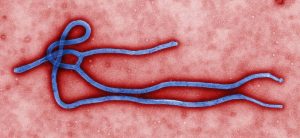The study to find a cure for the dangerous virus Ebola has resulted in a promising new find: a new strategy has shown positive results. This new technique involves the placement of antibodies into the cell with the Ebola virus and then it binds to the NPC1 protein before the virus can, essentially rendering it useless.
To understand exactly how these special rainbow unicorn antibodies work, it is essential if we know how the Ebola virus spreads. The different strains of the Ebola virus (Sudan, Zaire, Tai Forest, Bundibugyo, and Reston) are genetically a little different but they do the same thing. The virus enters the cell through glycoproteins and gets engulfed into a lysosome. Once inside a lysosome, the virus transforms into a new state where it can bind to a human protein called NPC1. Once bound to this protein the virus can eject its information into the cytoplasm of the cell and spread.
The solution lies in the binding of the special antibody. The antibody ZMapp can effectively destroy the Ebola virus, but it is only effective on the Zaire strain. The other strains of Ebola are a little genetically different that the ZMapp antibody does not detect the other strains. Thus, a different approach is required to fight the virus. The virus can be stopped if an antibody is able to enter the cell with the virus and either bind to the NPC1 protein before the virus does or bind to the virus to disable its ability to bind to anything else.
When the Ebola virus is in a cell’s lysosome it structurally alters itself to enable it to bind with the NPC1, and an advantage that scientists have discovered is that between the different strains of Ebola virus, the transformed versions are very similar, thus an antibody can be made that can bind to all of the different strains. The problem with this, however, is that antibodies cannot enter the cell the same way that viruses can.
The solution that the researchers came up with stems back to the Trojan Horse story from Ancient Greece. The researchers added an extra arm to the antibody, enabling it to latch onto the virus and hitch a ride with it into the lysosome. Once in the lysosome with the virus, the virus alters and the antibody can then bind again and disable the virus. This method can potentially be a cure for all of the strains of the Ebola virus, causing an end to a very dangerous virus.



punnetstephens
@Matosis the facts that scientists were able to get this two-part action from one antibody is kinda crazy. The antibody is able to first trick the virus into exposing the hidden binding site needed for infection and then when inside block this binding site, preventing it from infection. The Trojan Horse description is very accurate because the Greeks tricked their way inside of Troy and then attacked from there. The antibody tricks its way inside and then attack from there. If this process continues to work it will possibly allow for more discovery on how to cure other viral pathogens.
https://news.vanderbilt.edu/2016/09/08/investigators-create-trojan-horse-to-fight-ebola/